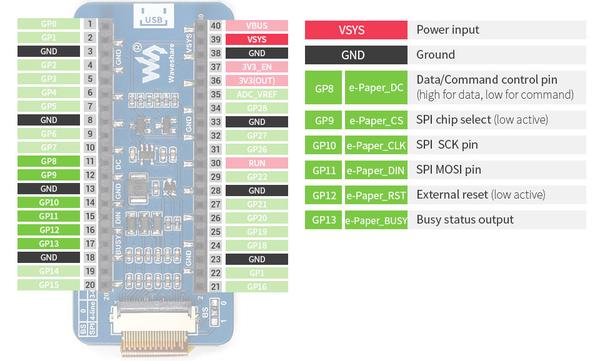This display module has been designed for the Raspberry Pi Pico – you just push your Pico into the female headers and you're ready to go.
E-paper display utilizes microcapsule electrophoretic technology for displaying, the principle is: charged particles suspended in clear fluid will move to sides of microcapsule when electric field is applied, making the microcapsule become visible by reflecting ambient light, just as traditional printed paper.
E-paper display will clearly display images/texts under lamplight or natural light, requires no backlight, and features nearly up to 180° viewing angle. It is usually used as e-reader due to its paper-like effect.
2.13inch e-Paper is an Active Matrix Electrophoretic Display (AMEPD), with interface and a reference system design. The 2.13” active area contains 250×122 pixels, and has 1-bit B/W full display capabilities. An integrated circuit contains gate buffer, source buffer, interface, timing control logic, oscillator, DC-DC. SRAM.LUT, VCOM and border are supplied with each panel.
Features
• Support partial refresh
• 250×122 pixels display
• High contrast
• High reflectance
• Ultra wide viewing angle
• Ultra low power consumption
• Pure reflective mode
• Bi-stable display
• Commercial temperature range
• Landscape, portrait modes
• Hard-coat antiglare display surface
• Ultra Low current deep sleep mode
• On chip display RAM
• Low voltage detect for supply voltage
• High voltage ready detect for driving voltage
• Internal temperature sensor
• 10-byte OTP space for module identification
• Waveform stored in On-chip OTP
• Serial peripheral interface available
• On-chip oscillator
• On-chip booster and regulator control for generating VCOM, Gate and Source driving voltage
• I2C signal master interface to read external temperature sensor/built-in temperature sensor
- Designed specifically for the Raspberry Pi Pico
- No soldering required
- 2.13″ display
- 170° viewing angle
- No backlight – keeps displaying last content for a long time even when power down
- Ultra-low power consumption – power is only required for refreshing
- SPI interface – requires minimal IO pins

Specifications
